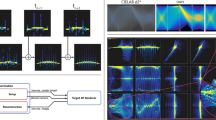Abstract
Rapid visualization is essential for maximum intensity projection (MIP) rendering, since the acquisition of a perceptual depth can require frequent changes of a viewing direction. In this paper, we propose a CPU-based real-time MIP method that uses parallelization operations with the AVX instruction set. We improve shear-warp based MIP rendering by resolving the bottle-neck problems of the previous method of a matrix transposition. We propose a novel matrix transposition method using the AVX instruction set to minimize bottle-neck problems. Experimental results show that the speed of MIP rendering on general CPU is faster than 20 frame-per-second (fps) for a 512 × 512 × 552 volume dataset. Our matrix transposition method can be applied to other image processing algorithms for faster processing.











Similar content being viewed by others
Change history
31 October 2017
The authors regret that acknowledgment of the financial support of the first author was omitted from the manuscript.
References
Belina S, Cuk V, Klapan I (2009) Virtual endoscopy and 3D volume rendering in the management of frontal sinus fractures. Coll Antropol 33:43–51
Chen K, Duan Y, Yan L, Sun J, Guo Z (2012) Efficient SIMD optimization of HEVC encoder over X86 processors. Signal & Information Processing Association Annual Summit and Conference (APSIPA ASC), pp 1–4
Cui J, Liu Y, Xu Y, Zhao H, Zha H (2013) Tracking generic human motion via fusion of low- and high-dimensional approaches. IEEE Trans Syst Man Cybern Syst 43(4):996–1002
Dachille F, Kreeger K, Chen B, Bitter I, Kaufman A (1998) High-quality volume rendering using texture mapping hardware. SIGGRAPH/Eurographics Workshop on Graphics Hardware’98, pp 69–76
Fang L, Wang Y, Qiu B, Qian Y (2002) Fast maximum intensity projection algorithm using shear warp factorization and reduced resampling. Magn Reson Med 47:696–700
Kiefer G, Lehmann H, Weese J (2006) Fast maximum intensity projections of large medical data sets by exploiting hierarchical memory architectures. IEEE Trans Inf Technol Biomed 10(2):385–394
Kye H (2009) Efficient maximum intensity projection using SIMD instruction and streaming memory transfer. J Korea Multimedia Soc 12(4):512–520
Lacroute P (1995) Fast volume rendering using a shear-warp factorization of the viewing transformation. Technical Report: CSL-TR-95-678
Lacroute P, Levoy M (1994) Fast volume rendering using a shear-warp factorization of the viewing transformation. Proceeding SIGGRAPH ‘94 Proceedings of the 21st annual conference on Computer graphics and interactive techniques, pp 451–458
Liu Y, Zhang X, Cui J (2010) Visual analysis of child-adult interactive behaviors in video sequences. 16th International Conference on Virtual Systems and Multimedia, pp 26–33
Liu Y, Cui J, Zhao H, Zha H (2012) Fusion of low-and high-dimensional approaches by trackers sampling for generic human motion tracking. 21st International Conference on Pattern Recognition, pp 898–901
Liu Y, Nie L, Han L, Zhang L, Rosenblum DS (2015) Action2Activity: recognizing complex activities from sensor data. Proceedings of the 24th International Conference on Artificial Intelligence, pp 1617-1623
Liu Y, Nie L, Liu L, Rosenblum DS (2016) From action to activity: sensor-based activity recognition. Neurocomputing 181(12):108–115
Liu L, Cheng L, Liu Y, Jia Y, Rosenblum DS (2016) Recognizing complex activities by a probabilistic interval-based model. Proceedings of the Thirtieth AAAI Conference on Artificial Intelligence, pp 1266–1272
Lu Y, Wei Y, Liu L, Zhong J, Sun L, Liu Y (2017) Towards unsupervised physical activity recognition using smartphone accelerometers. Multimedia Tools Appl 76(8):10701–10719
McFarlin DS, Arbatov V, Franchetti F, Püschel M (2011) Automatic SIMD vectorization of fast fourier transforms for the larrabee and AVX instruction sets. Proceedings of the international conference on Supercomputing, pp 265–274, Tucson, Arizona, USA
Mensmann J, Ropinski T, Hinrichs KH (2010) An advanced volume raycasting technique using GPU stream processing. International Conference on Computer Graphics Theory and Applications, pp 190–198
Mora B, Ebert DS (2005) Low-complexity maximum intensity projection. ACM Trans Graph 24(4):1392–1416
Mroz L, König A, Gröller E (1999) Real-time maximum intensity projection. Data Visualization ‘99, pp 135–144
Mroz L, Hauser H, Gröller E (2000) Interactive high-quality maximum intensity projection. Comput Graphics Forum 19(3):341–350
Pekar V, Hempel D, Kiefer G, Busch M, Weese J (2003) Efficient visualization of large medical image datasets on standard PC hardware. Joint EUROGRAPHICS - IEEE TCVG Symposium on Visualization, pp 135–140
Rezk-Salama C, Engel K, Bauer M, Greiner G, Ertl T (2000) Interactive volume rendering on standard PC graphics hardware using multi-textures and multi-stage-rasterization. Proceedings of SIGGRAPH/Eurographics Workshop on Graphics Hardware’00, pp 109–118
Sabella P (1988) A rendering algorithm for visualizing 3D scalar fields. ACM SIGGRAPH 1988 Proceedings of the 15th annual conference on Computer graphics and interactive techniques, pp 51–58
Schreiner S, Galloway RL Jr (1993) A fast maximum-intensity projection algorithm for generating magnetic resonance angiograms. IEEE Trans Med Imaging 12(1):50–57
Vollrath JE, Weiskopf D, Ertl T (2005) A generic software framework for the gpu volume rendering pipeline. Proceedings of Vision, Modeling, and Visualization, pp 391–398
Zekri AS (2014) Enhancing the matrix transpose operation using intel avx instruction set extension. Int J Comput Sci Inf Technol (IJCSIT) 6(3):67–78
Zhao K, Sakamoto N, Koyamada K (2014) Fused visualization for large-scale time-varying volume data with adaptive particle-based rendering. AsiaSim 2014, 14th International Conference on Systems Simulation, pp 228–242
Acknowledgements
This research was supported by the Basic Science Research Program through the National Research Foundation of Korea (NRF) funded by the Ministry of Science, ICT and Future Planning (No. 2017R1A2B3011475).
Author information
Authors and Affiliations
Corresponding author
Rights and permissions
About this article
Cite this article
Kye, H., Lee, S.H. & Lee, J. CPU-based real-time maximim intensity projection via fast matrix transposition using parallelization operations with AVX instruction set. Multimed Tools Appl 77, 15971–15994 (2018). https://doi.org/10.1007/s11042-017-5171-2
Received:
Revised:
Accepted:
Published:
Issue Date:
DOI: https://doi.org/10.1007/s11042-017-5171-2







